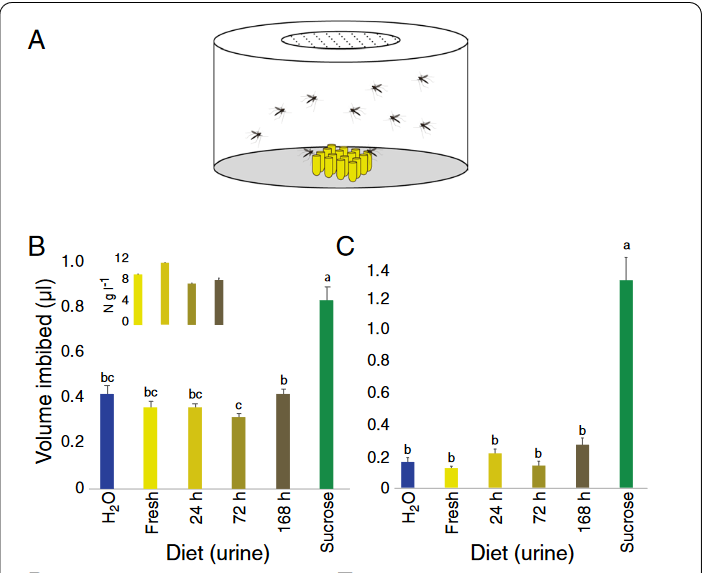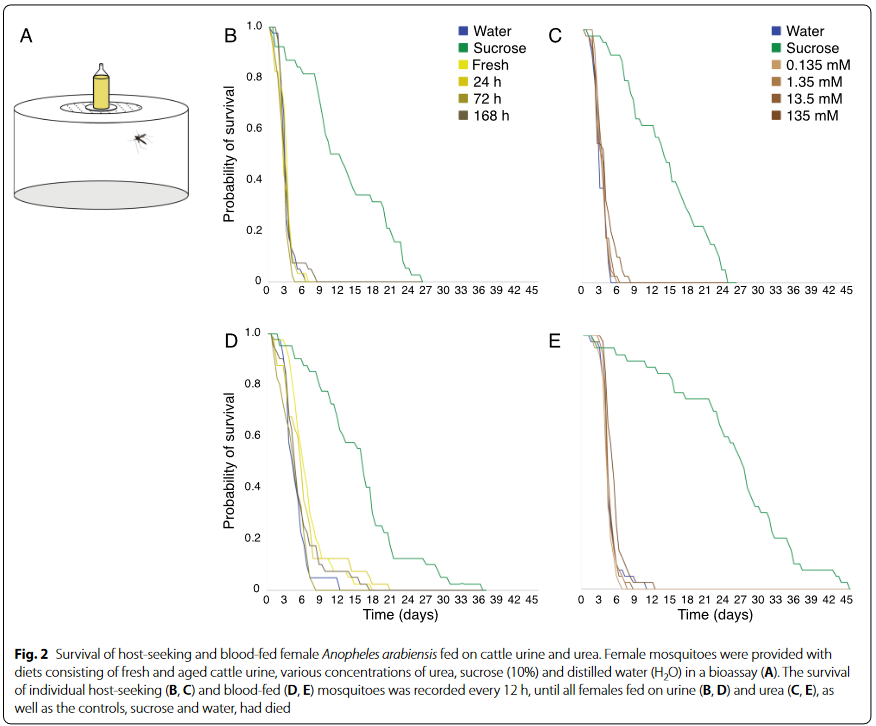
Puddling
Insects, such as mosquitoes, often supplement their nutrients by feeding from animal secretions – a term known as ‘puddling’. In the case of the mosquito Anopheles arabiensis, the adults emerge in an undernourished form and therefore need to obtain supplementary nutrients for survival and such activities as flying or reproduction.
Host seeking vs blood fed
In their paper in Malaria Journal, Mengistu Dawit and colleagues studied the ‘puddling’ behavior of An. arabiensis to determine if they obtained nutrients from cattle urine. They looked at the urine feeding pattern of blood starved mosquitoes (host-seeking) and those that had been fed a blood meal. Both sets of mosquitoes fed the most when given a sucrose solution (unsurprisingly), but the host seeking mosquitoes imbibed more urine (fresh and stale) than their counterparts.
Unsurprisingly, both sets of mosquitoes preferred fresher urine because urea and other compounds had not yet been broken down in the urine at this stage. What was interesting is that whilst they did not consume much of the 72 hour old urine, they drank more of the much older 168-hour stale urine.

When fed just urea – the component of urine containing the organic nitrogen that mosquitoes need – the optimum concentration of urea was 2.69 mM for both sets of mosquitoes. However, blood fed mosquitoes drank more of the solutions with lower concentrations of urea, and the host seeking mosquitoes imbibed more of the higher concentrations of urea. This shows that these mosquitoes regulate the concentration of nitrogen in their bodies by changing the volume of solution they drink.
What the extra nutrients from urine are used for depends on the physiological stage of the mosquito. Host seeking mosquitoes allocated their nutrients for survival and flight, whilst blood fed mosquitoes didn’t fly so much after drinking urine. The blood fed mosquitoes, therefore, allocated their nutrients towards egg laying and survival.
The cost of a urine diet
There is, as with many things, a cost to the consumption of cattle urine to obtain nutrients. As urine ages, urea and other compounds within it are broken down by bacteria into toxic compounds such as ammonia, reducing the life of the mosquitoes that drink the stale urine. Specifically, 72 hour old urine affected the survival rate of both sets of mosquitoes the most, but host seeking mosquitoes were more severely affected than blood fed mosquitoes across all urine ages.

The impact of the urine diet is also seen in egg number and size, as well as larval size. Fresh urine (24 hours) produced the higher yields of eggs, bigger eggs and bigger larvae. The stale 168-hour urine drastically reduced egg number, size and larval size.
In short, the mosquito has to offset the reduced lifespan with their need to either reproduce or for flight when seeking a blood meal.
The study of mosquito puddling is interesting and gives insight into mosquito behavior, but in a more practical sense it also provides a target for exploitation in vector control measures.

Comments